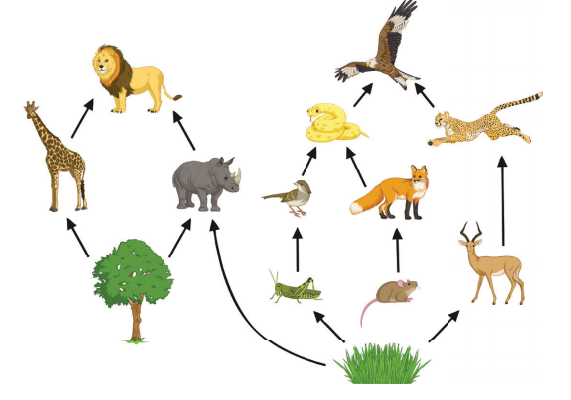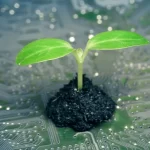The plants convert the radiant energy of sun into chemical energy and store them as complex molecules; this is the food energy stored in plants. This food energy is transferred to the primary consumers while the plant is consumed. When the large consumers feed on the primary consumers, the food energy is transferred to them. The transfer of food energy through a chain of organisms is called the “food chain”. Each organism in the ecosystem is assigned a feeding level depending on its nutritional status. The level of energy flow in each link of the food chain is called ‘trophic level’.
There are three types of food chain viz i) prey predator, ii)detritus and iii) parasitic food chains. Prey predator food chain is also called grazing food chain: grass land ecosystem, pond ecosystem, marine ecosystem and forest ecosystem. Detritus food chain is also called as saprophytic food chain like mangrove habitat. Parasitic chain goes from larger to smaller organisms. These food chains are not isolated units but are hooked together on food webs.
Flow of energy through an ecosystem in a way parallels the flow of food through the food chain. Photosynthesis is the process through which solar energy breaks the chemical bonds of carbon dioxide and water molecules forming new molecules of carbohydrates and oxygen. Respiration transforms carbohydrates and oxygen back into carbon dioxide, water and energy. The energy released in this process powers the chemical and physical processes of life, growth, reproduction and so on. Photosynthesis and respiration are the processes of the carbon and oxygen cycles in ecosystems.
FOOD WEB:
Neither do most primary consumers feed upon just one kind of plant, nor are they fed upon to only one kind of secondary consumer. Food web denotes the more complex pattern of feeding relationships among organisms. Food web is a network of food chains where different types of organisms are connected at different trophic levels, so that there are a number of options of eating and being eaten at each trophic level. Food webs give greater stability to the ecosystem. In a linear food chain, if one species becomes extinct or one species suffers then the species in the subsequent trophic levels are also affected. In a food web, there are a number of options available at each trophic level and hence if one species is affected it does not affect other trophic levels so seriously. Food chain and food web play an important role in the ecosystem, because the energy flow and nutrient cycling take place through them. Food chains regulate and maintain the population size of different animals, thereby maintaining the ecological balance. However, many heavy metals, pesticides and other chemicals are not bio-degradable and also not decomposed by micro organisms. These chemicals pass on from one trophic level to another and at each level they keep on increasing in concentration known as ‘biomagnifications’.
FUNCTIONS OF ECOSYSTEM
Ecosystem invariably performs in a systematic way under natural conditions. It converts the radiant energy of sun and pass it to biotic components.The biotic components exchange themselves and abiotic components the energy, nutrition and water for life processes. The main functions of an ecosystem are i) Energy flow, ii) food chain, iii) biochemical cycling of nutrients, iv) primary and secondary production and v) Ecosystem development and regulation.


